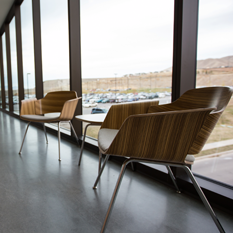Office Furniture for Small Spaces: Making the Most of Limited Square Footage
Many people now work remotely or from home, making it crucial to adapt to smaller office spaces. Whether you have a dedicated home office or are looking to maximize your workspace in a small commercial office, the right office furniture can make a significant difference.

In this blog, we will explore the challenges of working in small spaces and provide practical tips on how to select and arrange office furniture to make the most of limited square footage.
The Rise of Small Office Spaces
The trend of working from smaller office spaces is a result of various factors. Rising real estate costs, the flexibility of remote work, and the need to efficiently use limited resources have all contributed to this shift. However, working in a small space can be challenging, especially when it comes to office furniture. But with the right strategies and furniture choices, it is possible to create a functional and inspiring workspace.
Challenges of Small Office Spaces
Before diving into the solutions, let's first understand the common challenges associated with small office spaces:
1. Space Constraints
Limited square footage means you have less space to work with. This can make it challenging to fit in all the necessary office furniture and equipment without feeling cramped.
2. Clutter
In small spaces, clutter can accumulate quickly. Without proper organization and storage, a cluttered workspace can hinder productivity.
3. Lack of Privacy
Small spaces often lack the physical separation that larger offices offer. This can lead to distractions and a lack of privacy, which can be detrimental to work.
4. Aesthetics
Small spaces can easily feel overcrowded and uninviting if not designed thoughtfully. Creating an aesthetically pleasing workspace is essential for productivity and well-being.
Choosing the Right Office Furniture
Selecting the right office furniture for small spaces is essential to overcome the challenges mentioned above. Here are some tips to help you make the most of your limited square footage:
1. Multi-Functional Furniture
One of the most effective ways to maximize space is by investing in multi-functional furniture. For example, a desk with built-in storage, a fold-out wall desk, or a convertible sofa bed can serve multiple purposes, making the most of every inch of your office.
2. Vertical Storage
Utilise wall-mounted shelves, cabinets, and floating desks to keep your floor space open while providing ample storage for your office supplies and documents.
3. Compact Desk Solutions
Consider a compact desk that doesn't take up too much space but offers a comfortable and functional workspace. Wall-mounted desks or corner desks are great options for small offices.
4. Ergonomic Furniture
Don't compromise on ergonomic comfort. Opt for an ergonomic chair and keyboard tray that can be adjusted to your body and workspace, ensuring that you can work comfortably in a confined area.
5. Light Colours and Transparency
Light-coloured furniture and transparent materials can create an illusion of space. Glass desks, acrylic chairs, and light-coloured walls can make your small office appear more open and airy.
6. Cable Management
Keep cables and wires organized. Use cable clips, cable sleeves, or cable management boxes to prevent a tangled mess under your desk. This not only looks neater but also prevents accidents and damage.
Arranging Your Small Office Furniture
Selecting the right furniture is only part of the equation. How you arrange your office furniture is equally important. Here are some tips for optimising your small office layout:
1. Use the Vertical Space
As mentioned earlier, vertical storage is crucial. Install shelves and cabinets on the walls to keep your desk and floor clear. This creates a visually open space.
2. Create Zones
Divide your small office into different functional zones. Have a dedicated workspace, a storage zone, and a lounge or relaxation area if space permits. Clearly defined zones make your office feel more organized.
3. Furniture Placement
Place your desk in a way that maximizes natural light and provides a pleasant view if possible. This can help create a more inviting and inspiring workspace.
4. Keep it Tidy
Regularly declutter your office. Remove items that you don't need and maintain an organized and clutter-free workspace. This will not only make your office more functional but also improve your overall well-being.
5. Personalisation
Add personal touches to make your small office feel more inviting. Decorate with artwork, plants, or other items that inspire and motivate you.
Conclusion
Working in a small office space doesn't mean you have to sacrifice comfort, functionality, or style. With the right office furniture and thoughtful arrangement, you can make the most of limited square footage. By choosing multi-functional furniture, utilizing vertical storage, and creating a well-organized and personalized workspace, you can enhance your productivity and well-being in even the cosiest of offices. So, embrace the challenges and opportunities of small office spaces, and make your workspace a place where you can thrive.
- 11.09.2023
-
Category:
- Auditorium & Public Setting Blog